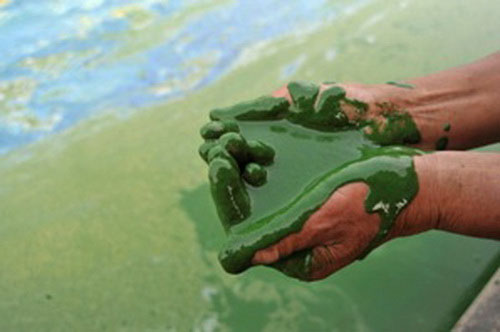Biofuel in the 'demon triangle' 3F
Fossil energy sources such as oil and coal are non-renewable sources of energy, which are gradually depleted. In this context, biofuels have been chosen to send gold as a promising 'candidate' to replace a part or all of the traditional fuel source mentioned above.

Algae - green biofuel source - Photo: Reuters
'Devil's triangle' 3F
Bio-fuels are produced from materials of biological origin (animals and plants) such as cereals: corn .; industrial crops: sugar cane, jatropha (jatropha) .; animal fat: catfish fat . This fuel has many outstanding advantages compared to renewable, environmentally friendly fossil fuels: their emissions are less more toxic.
However, the issue of producing and using bio-fuels in life is still limited due to many reasons. These reasons stem from a number of reasons, from economics (not yet lowering production costs to lower than traditional fossil fuels) to morality. On the moral side, scientists have generalized into '3F triangle triangle' to interpret them (see picture). 3F includes fuel: fuel (biology), food: food (for people), feed: food (for livestock). These three factors bind, dominate each other, on the one hand they create a competitive, competitive relationship, but on the other hand they can also support each other if there are reasonable coordination policies.
Obviously, if using food production land, traditional food for the purpose of fuel production, it will benefit in terms of fuel but along with the reduction of food production. This can push up food and food prices, creating food and food fever. The danger is the money label, which is harmless. But if rational use of fallow land, hilly land, and colorlessness to plant trees for fuel production, it will benefit a lot and cause little harm. Therefore, it is important to have specific and precise programs and planning of land areas for biofuel production, ensuring the balance of triangle 3F, serving sustainable development.
Biofuels in Vietnam
In the general trend of the world, in Vietnam, though late compared to other countries, the project 117 on 'Biofuel development to 2015, vision to 2020' has been approved by the Government. A number of factories producing bio-fuels (bio-ethanol: bio-ethanol) have been started construction as factories in Dung Quat Economic Zone and Phu Tho province. But so far, the rate of bio-fuels development in Vietnam has not been as expected.
In which the planning and development of material areas such as which land will be planted is still a hot topic. In recent years, the media have warned of the 'jatrophaification' phenomenon, ie 'the movement' to ask for land, including forest land, agricultural land, to grow jatropha in many localities. country. Besides, there is a business situation that is called to apply for jatropha land, but it is actually used to 'land part' of land.
Get rid of the 'demon triangle' 3F
The use of food as a biofuel production material in the long run is difficult to accept according to the relations in the 'demon triangle' 3F. To overcome that, many scientists are focusing on researching biofuel production in the second generation. It is the type of biofuel produced from agricultural, industrial and waste products . But there is a more 'trendy' trend, more promising, more advantageous in both economic and ownership aspects. The source of raw materials for production is processing . algae into green bio-fuels.
It will be cultivated on the water surface, like the sea surface, completely non-invasive, without land disputes, water sources with agricultural crops. Obviously, the production of bio-fuels from algae is a method to help humanity escape from the tension in the spiral of 3F triangle. A more positive future for mankind on biofuel production has been opened.
- The real solution for
- 'Devil's triangle' of doves
- The mysterious disappearances at the
- Bermuda Triangle Triangle, where the truth is buried
- Mysterious Chinese demon triangle
- The hidden secret of 165 years of the Bermuda Triangle Triangle has the answer
- The ghost ship suddenly returned after 91 years of disappearance in the Demon Triangle
- Terrestrial demon triangle: Mysterious Bridgewater Land
- Discovering the ancient city in Bermuda Triangle Triangle
- American people panicked when they discovered UFOs just outside the Bermuda Triangle
- New explanation for boats disappearing in the Bermuda triangle
- Discover the mystery of the
 Why do potatoes have eyes?
Why do potatoes have eyes? 'Tragedy' the world's largest carnivorous life: Death becomes ... public toilet
'Tragedy' the world's largest carnivorous life: Death becomes ... public toilet Tomatoes were once considered 'poisonous' for 200 years
Tomatoes were once considered 'poisonous' for 200 years Detecting microscopic parasites on human face
Detecting microscopic parasites on human face The world's shortest national border is only 85 meters long
The world's shortest national border is only 85 meters long  Using straw turns saline soil into fertile agricultural land
Using straw turns saline soil into fertile agricultural land  The most tragic creature: It took 300 million years to climb to land, but the journey ended at the dinner table
The most tragic creature: It took 300 million years to climb to land, but the journey ended at the dinner table  Virtual land 'unhabitable' sold for a record $ 2.4 million
Virtual land 'unhabitable' sold for a record $ 2.4 million  Many investors subdivide and buy virtual land on Mars
Many investors subdivide and buy virtual land on Mars  Humans have ushered in a new geological era of the Earth
Humans have ushered in a new geological era of the Earth 